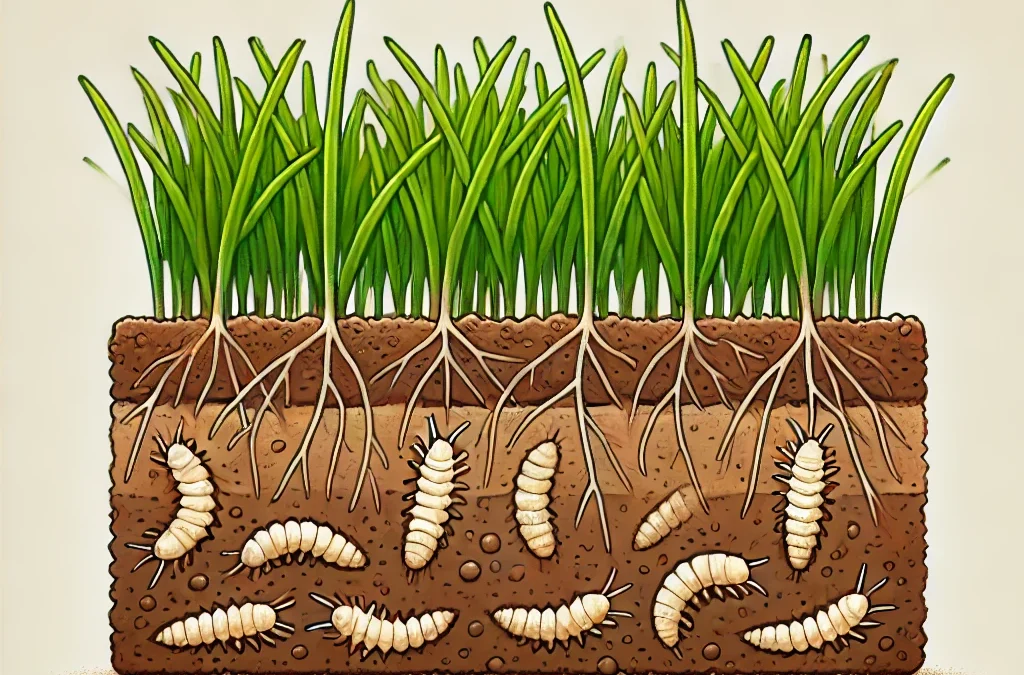When working to take great care of your lawn, nothing is more disheartening than seeing signs of brown or yellowing grass. While your instant reaction to the lawn damage may be to turn on the irrigation, the truth might be a little more creepy, crawly… and, dare I say, grubby.
(If you make a purchase using links in this post, we may earn a commission.)
Do Grubs Damage My Lawn?
While many insects (like earthworms or ladybugs) can provide health benefits for your grass, grubs are not one of them. Grubs are the larvae of moths and beetles, are white and worm-like, and feed on the roots of turfgrass. This causes unique damage to a lawn because it’s happening underground at the root level.
When the roots of your lawn are compromised, grass no longer efficiently takes in nutrients or water and ceases to thrive. Grub damage to a lawn can wreak havoc over the course of a growing season, causing discolored, wilted and even dead patches of grass.
What Are the Signs of Lawn Grubs?
Lawn grub damage can become a serious issue, so it’s important to see the signs as early as possible to start working on a solution. Read on to find some of the telltale signs of grubs on your lawn so you can take steps to prevent any future damage!

1. There Are Irregular Patches of Brown or Dead Grass
One of the first signs of lawn damage from grubs is finding oddly shaped, irregular brown spots of grass. Some areas may thin, while others turn brown and die.
While there can be many factors that play a part in turning grass brown, the irregularity of the brown patches may denote you’ve got a grub problem. You can check to make sure your grass is being properly watered and that there aren’t other signs of disease to help rule them out when considering grubs in the lawn.
2. Other Animals Are Hanging Out in Your Yard
When grubs start taking residency in your soil other animals with an appetite for the little critters will, too. If you start to notice birds, raccoons, skunks, moles, or armadillos spending more time than usual in your yard, they may be feeding on the grubs.
Not only is spotting other animals in your grass a sign of lawn grubs, it brings with it its own inherent issues. If animals start searching in your grass for grubs, they may dig and toss dirt during the hunt. This can cause damage to your turf that you may need to repair later as well.
3. There Are Moths / Beetles Flying Close to the Lawn
Have you noticed small moths flying around at grass level? Or maybe you’ve seen beetles hanging around near your yard? These small insects flying around your lawn could be a telltale grass grub sign.

White grubs are the larval stage of moths and beetles and eat the grass roots as they grow into maturity. When they are flying low around your grass, they are searching for a place to lay their eggs. Typically, they pick healthy grass that is moist, well-watered and has access to sunlight. Once the eggs are placed, they later grow into the larval grubs that cause lawn damage.
4. You Notice Spongy / Bouncy Spots in the Lawn
When you walk over your grass, does the lawn feel loose or bouncy under your feet? Because grubs go after the root system in a lawn, the upper turf can become loose, bouncy or spongy to the touch.
If the lawn grub damage gets worse, the lawn can go from spongy to fully detached. At this point, large areas of your lawn may need to be replaced after taking care of the pesky grubs underneath.
5. You’ve Seen Grubs in Your Soil
Lastly, the most obvious sign of lawn grubs is that you’ve actually seen them in your soil. Since grubs reside underground, one of the best and simplest ways to check for this is to get a shovel and dig up a few small areas near suspicious spots in your yard. To find the grubs, look for small worm-shaped bodies that are white in color, have brown heads, and are lying in a C-shape.
Keep in mind that having some grubs in your yard is completely normal. If you have 5 or more grubs per square foot of yard, however, you may have an infestation. If this is the case, then you should start a control treatment plan as soon as possible.
How Do You Get Rid of Lawn Damage from Grubs?
Once you’ve seen damage signs of grubs on your lawn and have confirmed they are there, it’s time to get rid of those grubs! While you may decide to enlist the help of a local lawn care service, there are many DIY grub control products to help get rid of the issue.
Some of the best grub killers for lawns include:
Buy – BioAdvanced Complete Insect Killer For Soil And Turf
BUY – Scotts GrubEx Season Long Grub Killer
BUY – GardenTech Sevin Insect Killer Lawn Granules
BUY – Mineiro 2F Flex Grub and Insect Control

When purchasing grub killers for your lawn, be sure to do some research to find out your climate zone and what time of year grubs are typically in the larval stage to make sure you apply it at the right time. If you apply the grub control too late, it may not effectively kill all the grubs and you might still see lawn damage from grubs.
See The Grass Grub Signs and Take Action
No matter what direction you go with grub control, spotting the signs is the crucial first step. If you have any questions or comments on how to spot grub damage in your lawn, leave them below!

